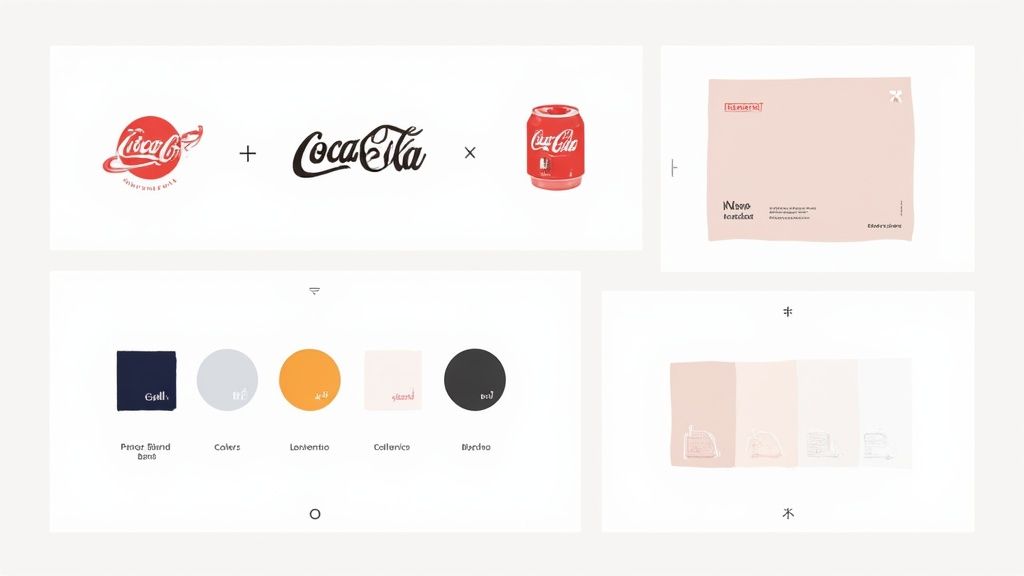Building a Brand that Matters in 2025
Ready to build a brand that truly resonates? Whether you're a solopreneur, aspiring creator, career pivoter, coach, or purpose-driven professional, these eight branding development strategies will provide the clarity and direction you need. Learn how to define your brand positioning, craft a compelling identity, connect through storytelling, and build a digital experience that attracts the right audience. Discover the power of strategic partnerships, customer-centricity, brand extensions, and purpose-driven branding to stand out and thrive. This concise guide provides actionable branding development strategies to help you make an impact.
1. Brand Positioning Strategy
Brand positioning is the cornerstone of any successful branding development strategy. It's the process of strategically crafting and presenting your brand to occupy a unique and desirable space in the minds of your target audience. It's about defining what makes you different, what value you bring, and why customers should choose you over the competition. Effective positioning clearly communicates your brand's value proposition, creating a distinct perception that resonates deeply with your target demographic and fuels sustainable growth. For solopreneurs, aspiring creators, career pivoters, coaches, consultants, and purpose-driven professionals, brand positioning provides a crucial roadmap for building a brand that attracts the right clients and opportunities.

Think of your brand as a product on a crowded shelf. Without clear positioning, it gets lost in the noise. But with strategic positioning, your brand shines a spotlight on its unique value, drawing the attention of your ideal customer. This strategy involves focusing on specific attributes, benefits, or values that differentiate you and create a compelling reason for customers to connect with your brand. It's about crafting a mental "space" in the consumer's mind where your brand resides as the go-to solution for their specific needs. You can learn more about Brand Positioning Strategy for a deeper dive into the topic.
Features of Effective Brand Positioning:
- Clear differentiation from competitors: What makes you stand out? What unique problem do you solve?
- Focus on specific attributes, benefits, or values: Are you the most affordable? The most innovative? The most reliable?
- Communicates a unique value proposition: What distinct value do you offer your customers?
- Creates mental "space" in the consumer's mind: What immediate thought or feeling do you want consumers to associate with your brand?
Pros:
- Helps brands stand out in crowded markets: Cut through the noise and capture attention.
- Makes marketing messages more focused and effective: Target your ideal customer with precision.
- Creates stronger emotional connections with target audiences: Build loyalty and advocacy.
- Justifies premium pricing when positioned as high-value: Command higher prices based on perceived value.
Cons:
- Can limit growth if positioning is too narrow: Be careful not to box yourself in.
- Difficult to change once established: Consistency is key.
- Requires consistent reinforcement across all touchpoints: Every interaction must reflect your positioning.
- May alienate some potential customers outside target segment: Focus on attracting your ideal client, not everyone.
Examples of Successful Brand Positioning:
- Volvo: Safety. They own this attribute in the automotive industry.
- Apple: Innovation, user-friendliness, and premium quality. Their products are seen as status symbols.
- Southwest Airlines: Fun, low-cost air travel. They've built a brand around a lighthearted, budget-friendly experience.
- Whole Foods: Healthy, organic grocery options. Their positioning appeals to health-conscious consumers.
Actionable Tips for Developing Your Brand Positioning:
- Conduct thorough market research: Understand your target audience and their needs. Identify gaps in the market that your brand can fill.
- Develop a clear, concise positioning statement: Summarize your brand's unique value proposition in a single sentence.
- Ensure all brand touchpoints reinforce positioning: From your website and social media to your customer service and packaging, every interaction should communicate your positioning.
- Regularly assess if positioning remains relevant as markets evolve: Stay adaptable and adjust your positioning as needed.
Brand positioning deserves its place at the top of this list because it's the foundation upon which all other branding development strategies are built. It provides direction, clarity, and focus, enabling you to build a strong, resonant brand that attracts the right customers and achieves lasting success. Whether you're a solopreneur building a service business, an aspiring creator finding your voice, or a career pivoter seeking direction, a well-defined brand position empowers you to stand out, connect with your audience, and build a thriving brand.
2. Brand Identity Development
Brand identity development is the cornerstone of any successful branding development strategy. It's the process of crafting a unique visual and verbal identity that embodies your brand's essence and resonates with your target audience. This comprehensive process goes far beyond simply designing a logo. It involves carefully selecting color palettes, typography, imagery styles, and crafting a distinct tone of voice that aligns perfectly with your brand values and positioning. Essentially, it's about translating the intangible aspects of your brand into tangible elements that consumers can readily recognize, connect with, and ultimately, trust. A well-defined brand identity helps you cut through the noise of a crowded marketplace and establish a lasting presence in the minds of your ideal clients.

For solopreneurs building service businesses, aspiring creators posting content, career pivoters starting over, coaches and consultants seeking the right clients, and purpose-driven professionals craving more meaning, brand identity development is paramount. It’s the foundation upon which you build recognition, trust, and differentiation. Whether you're a solopreneur offering unique coaching services or a content creator trying to carve your niche, a robust brand identity provides the clarity and direction you need to resonate with your ideal audience.
Features of a Strong Brand Identity:
- Visual System: This encompasses your logo, color palette, typography choices, and the overall style of your imagery. Think of the minimalist swoosh of Nike or the iconic script of Coca-Cola – these visual elements instantly communicate brand values.
- Verbal Identity: This includes the language you use, the tone of your messaging, and the overall voice of your brand. Is it playful? Authoritative? Empathetic? Your verbal identity should seamlessly complement your visuals.
- Brand Guidelines Documentation: A comprehensive document outlining the proper usage of your brand’s visual and verbal elements. This ensures consistency across all platforms.
- Sensory Elements: While often overlooked, engaging other senses like sound, touch, and even smell (when applicable) can further elevate your brand experience.
Benefits of Investing in Brand Identity Development:
- Instant Recognition: A strong visual identity creates immediate recognition in the crowded marketplace.
- Builds Trust and Credibility: Consistent application of your brand identity fosters trust and professionalism.
- Differentiation: A unique identity helps you stand out from competitors, attracting your ideal clients.
- Intangible Business Value: A well-defined brand identity is a valuable asset that contributes significantly to your overall business worth.
Weighing the Pros and Cons:
Pros: Creates instant recognition, builds trust through consistency, differentiates from competitors, adds significant business value.
Cons: Can be expensive and time-consuming to develop properly, requires consistent application across all touchpoints, may need periodic refreshing, can be difficult to change once established.
Actionable Tips for Developing Your Brand Identity:
- Strategy First, Design Second: Before sketching logos, define your brand strategy. Who are you serving? What are your core values? What makes you unique?
- Create Comprehensive Guidelines: Document everything! This ensures consistent brand application across all platforms and by all team members.
- Test Your Identity: Gather feedback from your target audience before finalizing your brand identity.
- Ensure Cross-Platform Consistency: Your identity should look and feel cohesive across all platforms, from your website to social media.
- Balance Distinctiveness with Timelessness: Aim for a unique identity that also stands the test of time, avoiding the need for frequent and costly redesigns.
Examples of Successful Brand Identity Development:
- Coca-Cola: The iconic red color, distinctive bottle shape, and script logo instantly evoke feelings of happiness and nostalgia.
- Nike: The minimalist swoosh logo and "Just Do It" tagline convey power, motivation, and athleticism.
- Tiffany & Co.: The signature robin's egg blue color and elegant typography communicate luxury and sophistication.
Learn more about Brand Identity Development
This element deserves its place in the list of branding development strategies because it’s the very essence of what makes a brand recognizable, memorable, and trustworthy. By investing in a thoughtfully crafted brand identity, you’re not just creating a logo – you’re building a powerful asset that fuels growth and fosters long-lasting connections with your audience. Inspired by the work of pioneers like Paul Rand, Wally Olins, Landor Associates, and Pentagram, take the time to create a brand identity that truly represents your unique value proposition.
3. Brand Storytelling
Brand storytelling is more than just weaving a captivating tale; it's the very essence of forging a deep and meaningful connection with your audience. It's about transforming your brand's dry facts – its history, values, and mission – into vibrant narratives that resonate on an emotional level, making your brand not just recognizable, but relatable and memorable. In the crowded marketplace, where countless businesses offer similar products or services, brand storytelling empowers you to cut through the noise and connect with your ideal customers on a human level. This strategy moves beyond simply listing product features and delves into the why behind your brand, fostering deeper connections and unwavering loyalty with customers who share your values and aspirations. For solopreneurs, aspiring creators, career pivoters, coaches, consultants, and purpose-driven professionals, this approach offers a powerful way to stand out, attract the right clients, and build a brand that truly reflects their purpose.

Brand storytelling leverages a narrative framework to bridge the gap between your brand and your consumers' emotions. This involves crafting compelling origin stories that explain how your brand came to be, sharing authentic customer stories that showcase the positive impact of your offerings, and articulating your vision and mission through inspiring narratives. By weaving consistent themes and characters across all your communications, you create a cohesive and recognizable brand identity. This narrative thread should be deployed across multiple channels, from your website and social media platforms to email marketing and even in-person interactions. This multi-channel approach ensures a consistent and immersive brand experience for your audience, reinforcing your message and building deeper connections.
Examples of successful brand storytelling:
- Patagonia: Their stories of environmental activism and responsible business practices resonate deeply with environmentally conscious consumers, fostering a loyal following.
- Airbnb: The "Belong Anywhere" narrative taps into the universal desire for connection and belonging, creating a sense of community around their platform.
- TOMS: The impactful one-for-one story of social entrepreneurship resonates with customers who want to make a difference with their purchases.
- Nike: Their stories of athletic achievement and overcoming obstacles inspire and motivate athletes of all levels.
Actionable Tips for Crafting Your Brand Story:
- Ground your stories in authenticity: Ensure your narratives are rooted in your genuine brand values and experiences. Inauthenticity can be easily detected and will damage your credibility.
- Prioritize emotional resonance: Connect with your audience's feelings and aspirations. Facts are important, but emotion is what truly drives connection.
- Showcase real-world impact with customer stories: Let your customers do the talking! Their experiences offer powerful testimonials to the value you provide.
- Develop adaptable story frameworks: Create a narrative structure that can be tailored and applied across various communication channels for consistency.
- Empower your team: Train all customer-facing staff to understand and communicate the brand story, ensuring a unified brand voice across all interactions.
Pros of Brand Storytelling:
- Creates emotional connections that drive brand loyalty: Consumers are more likely to stay loyal to brands they feel emotionally connected to.
- Makes brand messages more memorable and shareable: Compelling stories are more easily remembered and shared, extending your brand's reach organically.
- Humanizes brands: This is especially crucial in technical or corporate sectors, where building trust and relatability can be a challenge.
- Differentiates your brand: A unique narrative sets you apart from competitors relying solely on product features.
Cons of Brand Storytelling:
- Requires authenticity: If not aligned with the actual brand experience, storytelling can feel inauthentic and damage your reputation.
- Demands creative talent: Crafting compelling narratives requires skill and creativity.
- Can be complex: Maintaining consistency across multiple channels requires careful planning and execution.
- Difficult to measure quantitatively: The impact of storytelling can be challenging to measure with traditional metrics.
Brand storytelling deserves its place in this list of branding development strategies because it's the most effective way to connect with your audience on a deeper level, build a strong brand identity, and foster lasting loyalty. By crafting compelling narratives that resonate with your target audience, you can transform your brand from a faceless entity into a relatable and trusted partner in their journey. For solopreneurs and aspiring creators, this can be the key to standing out in a saturated market. For career pivoters and coaches/consultants, it can be the foundation for attracting the right clients. And for purpose-driven professionals, it can be the vehicle for sharing their vision and making a meaningful impact on the world.
4. Digital Brand Experience Strategy
In today's interconnected world, a robust digital presence isn't just an advantage—it's a necessity. For solopreneurs, aspiring creators, career pivoters, coaches, consultants, and purpose-driven professionals alike, a Digital Brand Experience Strategy is the key to unlocking meaningful connections with your target audience and establishing a thriving brand. This branding development strategy focuses on crafting cohesive, engaging, and meaningful interactions with your brand across every digital touchpoint. It's about orchestrating your website, apps, social media, email marketing, and other digital channels to deliver a unified brand experience that deeply resonates with your values and positioning. This approach deserves its place in any branding toolkit because it empowers you to meet your customers where they are—online.
How It Works:
A Digital Brand Experience Strategy goes beyond simply having a website and social media profiles. It's about strategically designing every interaction a user has with your brand in the digital realm. This involves understanding your target audience's online behavior, identifying their preferred platforms, and tailoring your content and user experience to meet their specific needs and expectations. Imagine it as conducting an orchestra: each instrument (website, social media, email) plays its unique part, but they all harmonize to create a beautiful symphony—your brand experience.
Features and Benefits:
- Omnichannel Digital Presence with Consistent Experience: Maintain a consistent brand voice, visual identity, and messaging across all platforms.
- User Experience (UX) and Interface Design Aligned with Brand: Ensure your digital interfaces are intuitive, user-friendly, and reflect your brand personality.
- Content Strategy Tailored to Digital Platforms: Create engaging, platform-specific content that resonates with your target audience.
- Data-Driven Personalization Capabilities: Leverage data to personalize user experiences and deliver targeted content.
- Digital Ecosystem Mapping and Management: Understand and manage the interconnectedness of your digital channels.
Pros:
- Direct Connection: Enables direct relationships with consumers without intermediaries, fostering loyalty and trust.
- Data-Driven Insights: Provides valuable data for continuous improvement and informed decision-making.
- Personalization at Scale: Allows for personalization at scale, creating tailored experiences that resonate deeply.
- Immersive Experiences: Can create immersive brand experiences that captivate and engage your audience.
- Meeting Customers Online: Connects with your audience where they increasingly spend their time.
Cons:
- Technical Expertise: Requires significant technical infrastructure and expertise.
- Constant Evolution: The digital landscape changes rapidly, requiring constant updates and adaptation.
- High Expectations: Customers have high expectations for seamless and personalized digital experiences.
- Privacy Concerns: Requires careful consideration of data privacy and security.
- Cost: Can be expensive to implement comprehensively, especially for those starting out.
Examples of Success:
- Sephora: Seamlessly integrates its app, website, and in-store digital experiences for a unified brand experience.
- Nike: Built a robust digital ecosystem, from the Nike+ apps to customization platforms, empowering athletes and fostering a strong community.
- Starbucks: Offers mobile ordering, payment, and rewards integration, creating a convenient and personalized experience for coffee lovers.
Actionable Tips for Implementation:
- Map the Customer Journey: Visualize the entire customer journey across all digital touchpoints.
- Mobile-First Approach: Prioritize mobile experiences in your design and functionality.
- Data Infrastructure: Implement a robust data infrastructure to enable personalization.
- Brand Consistency: Maintain brand consistency while optimizing content and design for each platform.
- User Testing: Test your digital experiences with actual users throughout the development process.
Learn more about Digital Brand Experience Strategy
When and Why to Use This Approach:
A Digital Brand Experience Strategy is crucial for anyone building a brand in today's digital age. Whether you're a solopreneur launching your first service business, an aspiring creator building an online presence, or a seasoned professional pivoting your career, this approach helps you connect with your audience on a deeper level, build lasting relationships, and ultimately, achieve your business goals. By embracing a holistic and user-centered approach, you can create a truly memorable and impactful brand experience that sets you apart from the competition. Don’t just exist online, thrive online.
5. Co-Branding and Strategic Partnerships: Amplify Your Brand Through Collaboration
Co-branding and strategic partnerships represent a powerful branding development strategy, especially for solopreneurs, aspiring creators, career pivoters, coaches/consultants, and purpose-driven professionals seeking to establish themselves and expand their reach. This approach involves collaborating with another brand to create joint offerings, marketing initiatives, or experiences that leverage the strengths of both partners. It's a smart way to build brand awareness, reach new audiences, and add value to your existing offerings within the broader context of your branding development strategies.
How it Works:
Co-branding thrives on synergy. By combining your unique brand assets – your audience, reputation, and expertise – with those of a complementary partner, you create something greater than the sum of its parts. This could involve joint product development, shared marketing campaigns, or even combined brand identities for a specific project. Think of it as a mutually beneficial exchange where both partners gain access to resources and markets they might not have been able to reach independently.
Examples of Successful Implementation:
- Apple and Nike: The seamless integration of Nike+ technology into Apple devices created a powerful ecosystem for fitness enthusiasts, benefiting both brands.
- Spotify and Uber: In-ride music customization via Spotify enhances the Uber experience, adding value for passengers and increasing Spotify's reach.
- GoPro and Red Bull: Their collaborations on extreme sports content and events brilliantly align their target audiences and brand images.
These examples demonstrate the potential of co-branding to create innovative experiences and reach new heights within a robust framework of branding development strategies.
Actionable Tips for Successful Co-Branding:
- Ensure Strong Brand Alignment: Choose partners whose values and target audience align with your own. A mismatch can dilute your brand message and confuse your audience.
- Clearly Define Objectives: Establish clear goals and metrics for success from the outset to ensure both partners are on the same page.
- Create Detailed Agreements: Formalize the partnership with a comprehensive agreement outlining roles, responsibilities, and intellectual property rights.
- Maintain Brand Integrity: While collaborating, it's crucial to preserve the unique identity and voice of your brand. The collaboration should enhance, not overshadow, your individual brand.
- Develop an Exit Strategy: Plan for contingencies and establish a clear exit strategy in case the partnership doesn't work out as planned.
- Test and Iterate: Before a full launch, test co-branded concepts with your target audience to gather feedback and refine your approach.
When and Why to Use Co-Branding:
Co-branding is particularly effective when:
- Expanding Reach: You want to tap into new customer segments that are aligned with your brand but difficult to reach on your own.
- Building Credibility: Partnering with an established brand can lend credibility and trust to your brand, especially if you're a newcomer.
- Sharing Resources: Co-branding can help share the costs of product development and marketing campaigns, maximizing your resources.
- Differentiating Your Offer: In crowded markets, a strategic partnership can help create unique and compelling offerings that stand out from the competition.
Pros and Cons of Co-Branding:
Pros:
- Expands reach to new customer segments
- Adds credibility through association with established partners
- Shares development and marketing costs
- Creates differentiated offerings in crowded markets
- Accelerates growth and entry into new markets
Cons:
- Risk of brand dilution or confusion
- Complex legal and operational coordination required
- Potential for unequal benefit between partners
- Challenges if partner experiences reputation damage
- Difficult to dissolve partnerships without disruption
Co-branding deserves its place amongst branding development strategies because it offers a powerful avenue for growth and differentiation. By leveraging the strengths of complementary brands, you can achieve goals that would be difficult or impossible to reach alone. This is particularly valuable for solopreneurs and emerging brands seeking to establish a foothold in their respective markets. By carefully selecting partners, defining objectives, and managing the collaboration effectively, you can harness the synergistic power of co-branding to amplify your brand and achieve remarkable success.
6. Customer-Centric Brand Building
In the bustling marketplace of today, standing out requires more than just a catchy tagline. It demands a deep understanding of the very people you aim to serve. That's where customer-centric brand building comes in – a powerful branding development strategy that places your customer squarely at the heart of every decision. This approach recognizes that your brand isn't just what you say it is; it's what your customers experience and believe it to be.
Instead of leading with product features or company history, customer-centric branding starts by deeply understanding your customer’s needs, preferences, and pain points. It's about crafting brand experiences specifically designed to address these, fostering genuine connections, and ultimately, building unwavering loyalty. Are you a solopreneur building a service business? An aspiring creator unsure of your positioning? A career pivoter seeking direction? A coach/consultant needing to attract the right clients? Or a purpose-driven professional seeking more meaning in your work? This strategy will empower you to build a brand that resonates deeply with your target audience.
How it Works:
Customer-centric brand building is a continuous cycle of listening, learning, and adapting. It involves:
- Deep customer research and persona development: Go beyond demographics and delve into the motivations, aspirations, and challenges of your ideal customer. Create detailed personas that represent your target audience segments.
- Journey mapping across the entire customer lifecycle: Map out every interaction a customer has with your brand, from initial awareness to post-purchase engagement. Identify pain points and opportunities to enhance the experience at each touchpoint.
- Voice of customer feedback integration into brand strategy: Actively solicit and analyze customer feedback through surveys, reviews, social media listening, and direct interactions. Integrate these insights into your brand strategy and refine your messaging and offerings accordingly.
- Experience design focused on customer needs: Craft every aspect of your brand experience, from your website and marketing materials to your customer service interactions, with your customer’s needs in mind.
- Measurement systems based on customer satisfaction and loyalty: Track key metrics like customer satisfaction, Net Promoter Score (NPS), and customer lifetime value to measure the effectiveness of your customer-centric initiatives.
Examples of Success:
Think Amazon, with its relentless "customer obsession" as its first leadership principle. Consider Zappos, renowned for its extreme focus on customer service excellence. Or USAA, tailoring financial services specifically around the unique needs of military families. Even the Ritz-Carlton empowers its staff to create memorable customer experiences, showcasing how customer-centricity can elevate a brand to legendary status.
Actionable Tips for Implementation:
- Implement regular customer feedback mechanisms at all touchpoints.
- Create cross-functional customer experience teams.
- Empower frontline employees to resolve customer issues.
- Develop customer journey maps for different segments.
- Establish customer-focused metrics for all departments.
- Regularly share customer insights throughout the organization.
Pros and Cons:
Pros:
- Creates stronger emotional connections and loyalty
- Improves product-market fit and relevance
- Reduces acquisition costs through increased retention and referrals
- Provides clear direction for innovation and improvement
- Builds resilience against competitors and market changes
Cons:
- Can be resource-intensive to implement properly
- May slow decision-making due to research requirements
- Requires significant organizational alignment and culture shift
- Sometimes conflicts with short-term financial objectives
- Difficult to balance diverse customer segment needs
Why This Strategy Deserves Its Place:
In a world saturated with choices, customer-centricity isn't just a nice-to-have; it's a necessity. It's the cornerstone of sustainable growth and the key to differentiating your brand in a crowded marketplace. By prioritizing the customer experience, you're not just building a brand; you're building a community of loyal advocates who will propel your success.
Learn more about Customer-Centric Brand Building
This approach was popularized by visionaries like Jeff Bezos and his customer-first philosophy at Amazon, Tony Hsieh's revolutionary customer service approach at Zappos, Fred Reichheld, the creator of the Net Promoter Score, and Don Peppers and Martha Rogers' pioneering 1:1 marketing concept. By adopting this strategy, you're tapping into a proven framework for building a brand that not only survives but thrives in the modern era.
7. Brand Extension Strategy
Brand extension is a powerful branding development strategy that can propel your business to new heights by leveraging the hard-earned equity of your existing brand. Imagine taking the trust, recognition, and positive associations you've cultivated and using them as a springboard to launch exciting new offerings. That's the magic of brand extension. It's about strategically expanding your reach, diversifying your income streams, and solidifying your position in the market, all while minimizing the risks associated with launching a completely new brand. This strategy is particularly relevant for solopreneurs, aspiring creators, career pivoters, coaches/consultants, and purpose-driven professionals seeking to expand their impact and reach a wider audience.
What is Brand Extension and How Does it Work?
Brand extension involves using your established brand name and identity to introduce new products or services, often in a different category than your core offering. This leverages existing brand awareness, trust, and positive associations to penetrate new markets more efficiently and effectively. Think of it as building bridges from your existing stronghold to new territories ripe with opportunity.
Brand extensions can range from closely related offerings (like a yoga instructor launching a meditation app – an adjacent extension) to more distant ventures (like a successful author launching a line of organic teas – a distant extension). They can also involve vertical extensions, offering products or services at different price points or quality tiers to cater to a broader customer base. For instance, a freelance writer could offer premium editing services alongside their standard writing packages.
Examples of Successful Brand Extension:
- Virgin Group: Richard Branson's empire exemplifies successful brand extension, expanding from airlines to banking, telecommunications, and even space tourism.
- Dyson: Originally known for innovative vacuum cleaners, Dyson has successfully extended its brand to hand dryers, fans, and hair styling tools, capitalizing on its reputation for engineering excellence.
- Arm & Hammer: This brand cleverly extended from baking soda to toothpaste and laundry detergent, leveraging its association with freshness and cleaning power.
Actionable Tips for Implementing Brand Extension:
- Alignment is Key: Ensure your new offerings align seamlessly with your core brand values and overall positioning. A career coach extending into life coaching makes sense, whereas branching into selling handcrafted jewelry might not.
- Test the Waters: Before diving in headfirst, test your extension concepts with your existing audience. Gather feedback and refine your approach based on their responses.
- Architectural Awareness: Consider how new offerings impact your overall brand architecture. A clear and organized structure ensures clarity for both you and your customers.
- Maintain Quality Standards: Consistency is paramount. Maintain the same level of quality across all your offerings to avoid diluting your brand's reputation.
- Start Close, Go Far: Begin with closely related extensions before venturing into distant categories. This minimizes risk and allows for a more gradual expansion.
- Evaluation Criteria: Develop clear criteria for evaluating extension opportunities, ensuring they align with your overall business goals and brand strategy.
Pros of Brand Extension:
- Reduced Launch Costs and Risks: Leveraging an existing brand reduces the marketing and advertising expenses required to build awareness from scratch.
- Accelerated Consumer Adoption: Existing brand trust fast-tracks consumer acceptance of new offerings.
- Economies of Scale: Streamlined marketing and operations create cost efficiencies.
- Strengthened Brand Presence: Increased touchpoints reinforce brand visibility and top-of-mind awareness.
- New Growth Avenues: Brand extension breathes new life into mature brands, unlocking exciting growth potential.
Cons of Brand Extension:
- Brand Dilution: Poorly executed extensions can damage your brand’s reputation and erode consumer trust.
- Consumer Confusion: Extensions that don't align with your core brand can confuse your audience and weaken their connection with your brand.
- Cannibalization: New offerings might inadvertently compete with existing products, impacting overall sales.
- Damaged Parent Brand: Failed extensions can negatively impact the perception of your core brand.
- Strained Resources: Expanding into new areas can stretch organizational capabilities too thin.
Why Brand Extension Deserves Its Place in Your Branding Development Arsenal:
For solopreneurs, creators, and professionals building a personal brand, brand extension provides a strategic pathway to diversify offerings, expand reach, and maximize impact. It's a smart, efficient, and potentially lucrative strategy that allows you to leverage your existing brand equity to achieve greater success. By following these tips and carefully considering the potential pros and cons, you can harness the power of brand extension to unlock exciting new opportunities and build a thriving, multifaceted brand.
8. Purpose-Driven Branding
In today's increasingly conscious marketplace, consumers are seeking more than just products or services; they're seeking brands that resonate with their values. This is where purpose-driven branding, a powerful branding development strategy, comes into play. Purpose-driven branding centers a brand around a meaningful mission that extends beyond simply generating profit. It articulates why the brand exists, what positive impact it aims to create, and how it contributes to society or addresses significant challenges. This approach fosters authentic connections with consumers who share similar values and want their purchases to reflect their beliefs. It's about making a difference while making a living.

Purpose-driven brands don't just talk the talk; they walk the walk. They align their operations, communications, and initiatives with their stated mission. This includes values-based decision-making throughout the organization, integrating social or environmental commitments into their business model, and maintaining transparency regarding progress toward purpose-related goals. The focus shifts from solely serving shareholders to embracing a wider range of stakeholders, including employees, customers, the community, and the planet. For solopreneurs, aspiring creators, career pivoters, coaches/consultants, and purpose-driven professionals, this strategy offers a pathway to build a brand that truly resonates.
This approach offers numerous benefits. It creates deeper emotional connections with value-aligned consumers, fostering loyalty that transcends price fluctuations. It attracts and retains purpose-motivated employees who are passionate about the brand's mission. In crowded markets, purpose-driven branding offers a powerful differentiator, setting your brand apart from the competition. Learn more about Purpose-Driven Branding It even builds resilience against price competition as customers are often willing to pay a premium for brands aligned with their values. And finally, by focusing on solving meaningful problems, purpose-driven branding can be a powerful driver of innovation.
Of course, like any strategy, there are potential downsides. A commitment to purpose opens a brand to scrutiny and accusations of "purpose-washing" if actions don't align with words. It may also alienate consumers who don't share the brand's values. Sometimes, a focus on purpose can create tension with short-term profit goals, requiring a long-term perspective. Crucially, purpose-driven branding requires genuine organizational commitment, not just a marketing veneer. Finally, maintaining a consistent purpose can be challenging through leadership changes, necessitating a deep embedding of the mission within the organization's culture.
Think about Patagonia's environmental activism, TOMS' one-for-one giving model, Dove's "Real Beauty" campaign, or Ben & Jerry's social justice advocacy. These are all prime examples of purpose-driven branding in action, demonstrating the power of aligning a brand with a meaningful mission.
So, how can you implement purpose-driven branding?
- Identify a purpose that authentically connects to your brand's history and strengths. Don't just jump on the latest trend; find a cause that genuinely resonates with your core values.
- Ensure leadership commitment to the purpose beyond just marketing. This needs to be a company-wide embrace, not a superficial slogan.
- Integrate purpose into product development and operations. Let your purpose guide your actions, not just your words.
- Measure and transparently report the impact related to your purpose. Show, don't just tell.
- Train employees at all levels to understand and embody the purpose. Everyone in your organization should be an ambassador for your mission.
- Be prepared to take stands on relevant issues, even when controversial. Authenticity requires courage.
Purpose-driven branding deserves its place on this list because it addresses a fundamental shift in consumer behavior. It provides a framework for building a brand that not only sells products or services but also makes a positive impact on the world. By aligning your brand with a meaningful purpose, you can create a powerful connection with your audience, build a loyal following, and drive sustainable growth. It’s a winning strategy for both your business and the world around you.
8-Point Branding Strategy Comparison
| Strategy | 🔄 Complexity | ⚡ Resources | 📊 Outcomes | 💡 Ideal Use Cases | ⭐ Advantages |
|---|---|---|---|---|---|
| Brand Positioning Strategy | Moderate – Requires clear, consistent messaging | Low to Moderate – Focus on messaging | Distinct market niche; stronger emotional connections | Crowded markets; premium brands seeking differentiation | Clear differentiation; focused marketing |
| Brand Identity Development | High – Involves design, testing, and guidelines | High – Investment in visuals and branding | Cohesive, recognizable identity; increased trust | Brands needing visual differentiation and consistency | Instant recognition; builds long-term trust |
| Brand Storytelling | High – Involves creative narrative development | Moderate – Creative resources and planning | Emotional engagement; memorable brand narratives | Brands aiming for deeper emotional customer ties | Humanizes brand; enhances shareability |
| Digital Brand Experience Strategy | High – Requires sophisticated tech-ecosystem | High – Digital infrastructure and expertise | Seamless omnichannel engagement; personalized experiences | Digital-first brands; customer-centric online experiences | Immersive experience; data-driven personalization |
| Co-Branding and Strategic Partnerships | Moderate to High – Coordination across brands | Moderate – Shared costs and marketing efforts | Expanded reach; joint market penetration | Brands targeting new segments through collaborations | Shared costs; extended audience reach |
| Customer-Centric Brand Building | Moderate to High – Customer research intensive | Moderate – Investment in research and training | Enhanced loyalty; improved product-market fit | Mature businesses focused on customer retention | Stronger emotional connection; valuable insights |
| Brand Extension Strategy | Moderate – Leverages existing brand equity | Moderate – Utilizes existing resources | Successful entry into new product categories | Brands planning to diversify product/market offerings | Cost-efficient growth; economies of scale |
| Purpose-Driven Branding | High – Requires cultural alignment and transparency | Moderate – Commitment across the organization | Deeper connection; authentic brand differentiation | Mission-driven brands; value-centered market segments | Enhanced engagement; resilient differentiation |
Ready to Transform Your Brand?
Throughout this article, we've explored key branding development strategies, from defining your brand positioning and crafting a compelling brand identity to leveraging digital platforms and building strategic partnerships. We've also touched upon the importance of customer-centricity, brand storytelling, purpose-driven branding, and even brand extension for future growth. Mastering these concepts is crucial for anyone, whether you’re a solopreneur seeking differentiation, a creator building an audience, a career pivoter forging a new path, a coach needing to connect with ideal clients, or a purpose-driven professional seeking more meaning. By implementing these branding development strategies, you can cultivate a magnetic brand presence that attracts the right opportunities and propels you toward lasting success. Remember, your brand is more than just a logo; it's the essence of your value proposition, the embodiment of your unique story, and a reflection of the impact you want to make in the world. Embrace these strategies, and watch your brand, and your business, flourish.
Ready to take your branding to the next level? Henri Den offers powerful tools and resources to help you implement these branding development strategies effectively. Visit Henri Den today and discover how you can build a truly remarkable brand.






